生态学总结
- 格式:docx
- 大小:25.65 KB
- 文档页数:4
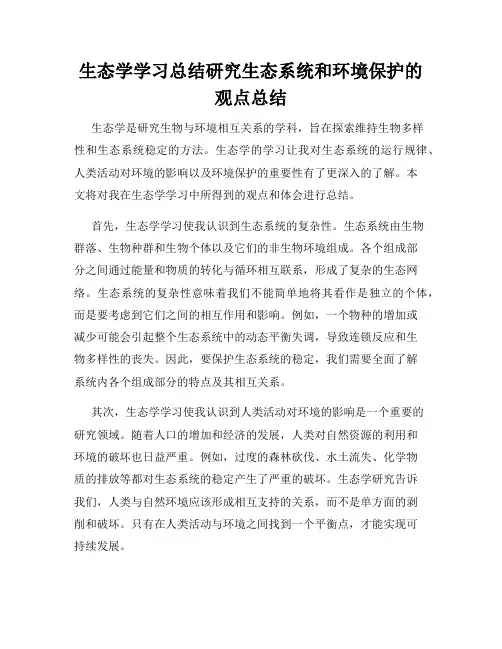
生态学学习总结研究生态系统和环境保护的观点总结生态学是研究生物与环境相互关系的学科,旨在探索维持生物多样性和生态系统稳定的方法。
生态学的学习让我对生态系统的运行规律、人类活动对环境的影响以及环境保护的重要性有了更深入的了解。
本文将对我在生态学学习中所得到的观点和体会进行总结。
首先,生态学学习使我认识到生态系统的复杂性。
生态系统由生物群落、生物种群和生物个体以及它们的非生物环境组成。
各个组成部分之间通过能量和物质的转化与循环相互联系,形成了复杂的生态网络。
生态系统的复杂性意味着我们不能简单地将其看作是独立的个体,而是要考虑到它们之间的相互作用和影响。
例如,一个物种的增加或减少可能会引起整个生态系统中的动态平衡失调,导致连锁反应和生物多样性的丧失。
因此,要保护生态系统的稳定,我们需要全面了解系统内各个组成部分的特点及其相互关系。
其次,生态学学习使我认识到人类活动对环境的影响是一个重要的研究领域。
随着人口的增加和经济的发展,人类对自然资源的利用和环境的破坏也日益严重。
例如,过度的森林砍伐、水土流失、化学物质的排放等都对生态系统的稳定产生了严重的破坏。
生态学研究告诉我们,人类与自然环境应该形成相互支持的关系,而不是单方面的剥削和破坏。
只有在人类活动与环境之间找到一个平衡点,才能实现可持续发展。
另外,环境保护是生态学研究的核心内容之一。
环境保护的目的是保护和改善环境质量,维护生态系统的稳定和功能。
在生态学学习中,我了解到环境保护需要从多个方面入手,包括保护自然资源、减少污染、节约能源等。
例如,要保护森林资源,我们应该加强森林保护、合理利用,避免过度砍伐和滥伐。
要减少污染,我们需要控制工业废水和废气的排放,加强环境监测和治理。
要节约能源,我们应该鼓励使用清洁能源,提高能源利用效率。
只有全社会共同努力,才能实现环境的可持续发展。
总的来说,生态学学习使我对生态系统和环境保护有了更深入的认识。
生态系统的复杂性要求我们综合考虑各种生物和环境因素之间的相互作用,才能实现生态系统的可持续发展。
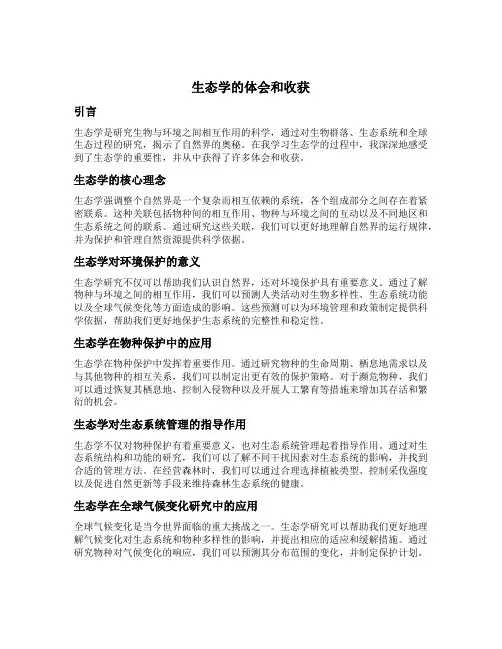
生态学的体会和收获引言生态学是研究生物与环境之间相互作用的科学,通过对生物群落、生态系统和全球生态过程的研究,揭示了自然界的奥秘。
在我学习生态学的过程中,我深深地感受到了生态学的重要性,并从中获得了许多体会和收获。
生态学的核心理念生态学强调整个自然界是一个复杂而相互依赖的系统,各个组成部分之间存在着紧密联系。
这种关联包括物种间的相互作用、物种与环境之间的互动以及不同地区和生态系统之间的联系。
通过研究这些关联,我们可以更好地理解自然界的运行规律,并为保护和管理自然资源提供科学依据。
生态学对环境保护的意义生态学研究不仅可以帮助我们认识自然界,还对环境保护具有重要意义。
通过了解物种与环境之间的相互作用,我们可以预测人类活动对生物多样性、生态系统功能以及全球气候变化等方面造成的影响。
这些预测可以为环境管理和政策制定提供科学依据,帮助我们更好地保护生态系统的完整性和稳定性。
生态学在物种保护中的应用生态学在物种保护中发挥着重要作用。
通过研究物种的生命周期、栖息地需求以及与其他物种的相互关系,我们可以制定出更有效的保护策略。
对于濒危物种,我们可以通过恢复其栖息地、控制入侵物种以及开展人工繁育等措施来增加其存活和繁衍的机会。
生态学对生态系统管理的指导作用生态学不仅对物种保护有着重要意义,也对生态系统管理起着指导作用。
通过对生态系统结构和功能的研究,我们可以了解不同干扰因素对生态系统的影响,并找到合适的管理方法。
在经营森林时,我们可以通过合理选择植被类型、控制采伐强度以及促进自然更新等手段来维持森林生态系统的健康。
生态学在全球气候变化研究中的应用全球气候变化是当今世界面临的重大挑战之一。
生态学研究可以帮助我们更好地理解气候变化对生态系统和物种多样性的影响,并提出相应的适应和缓解措施。
通过研究物种对气候变化的响应,我们可以预测其分布范围的变化,并制定保护计划。
生态学对人类社会的启示生态学不仅关注自然界,也对人类社会有着重要启示。
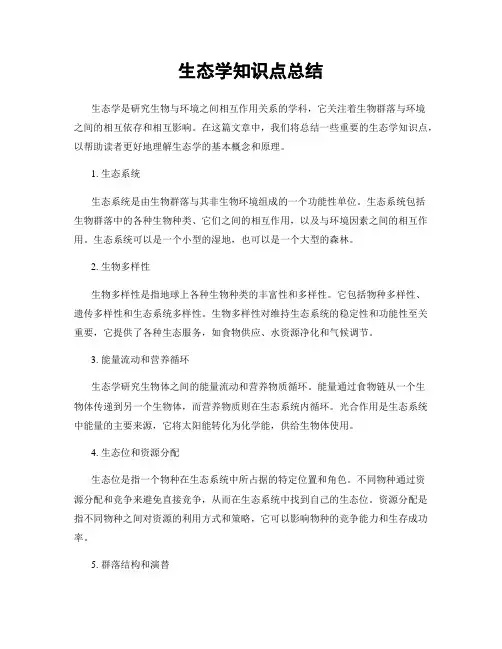
生态学知识点总结生态学是研究生物与环境之间相互作用关系的学科,它关注着生物群落与环境之间的相互依存和相互影响。
在这篇文章中,我们将总结一些重要的生态学知识点,以帮助读者更好地理解生态学的基本概念和原理。
1. 生态系统生态系统是由生物群落与其非生物环境组成的一个功能性单位。
生态系统包括生物群落中的各种生物种类、它们之间的相互作用,以及与环境因素之间的相互作用。
生态系统可以是一个小型的湿地,也可以是一个大型的森林。
2. 生物多样性生物多样性是指地球上各种生物种类的丰富性和多样性。
它包括物种多样性、遗传多样性和生态系统多样性。
生物多样性对维持生态系统的稳定性和功能性至关重要,它提供了各种生态服务,如食物供应、水资源净化和气候调节。
3. 能量流动和营养循环生态学研究生物体之间的能量流动和营养物质循环。
能量通过食物链从一个生物体传递到另一个生物体,而营养物质则在生态系统内循环。
光合作用是生态系统中能量的主要来源,它将太阳能转化为化学能,供给生物体使用。
4. 生态位和资源分配生态位是指一个物种在生态系统中所占据的特定位置和角色。
不同物种通过资源分配和竞争来避免直接竞争,从而在生态系统中找到自己的生态位。
资源分配是指不同物种之间对资源的利用方式和策略,它可以影响物种的竞争能力和生存成功率。
5. 群落结构和演替群落是指在同一地区内共同生活并相互作用的各种生物种类的总体。
群落结构包括物种组成、物种丰富度和物种相对丰度等方面。
演替是指群落随时间的变化和演化过程,它包括初级演替和次生演替两种类型。
6. 生态系统稳定性生态系统的稳定性是指在面对外部干扰或内部变化时,系统能够维持其结构和功能的能力。
生态系统的稳定性受到物种多样性、生物群落结构和营养循环等因素的影响。
稳定的生态系统能够更好地抵御环境变化和生物入侵的影响。
7. 生态学应用生态学的研究成果在许多领域都有广泛的应用。
例如,生态学可以帮助解决环境保护和自然资源管理的问题,促进可持续发展和生态恢复。
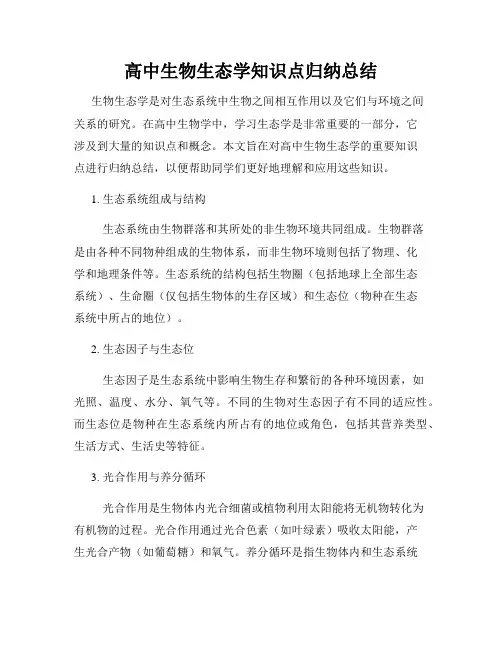
高中生物生态学知识点归纳总结生物生态学是对生态系统中生物之间相互作用以及它们与环境之间关系的研究。
在高中生物学中,学习生态学是非常重要的一部分,它涉及到大量的知识点和概念。
本文旨在对高中生物生态学的重要知识点进行归纳总结,以便帮助同学们更好地理解和应用这些知识。
1. 生态系统组成与结构生态系统由生物群落和其所处的非生物环境共同组成。
生物群落是由各种不同物种组成的生物体系,而非生物环境则包括了物理、化学和地理条件等。
生态系统的结构包括生物圈(包括地球上全部生态系统)、生命圈(仅包括生物体的生存区域)和生态位(物种在生态系统中所占的地位)。
2. 生态因子与生态位生态因子是生态系统中影响生物生存和繁衍的各种环境因素,如光照、温度、水分、氧气等。
不同的生物对生态因子有不同的适应性。
而生态位是物种在生态系统内所占有的地位或角色,包括其营养类型、生活方式、生活史等特征。
3. 光合作用与养分循环光合作用是生物体内光合细菌或植物利用太阳能将无机物转化为有机物的过程。
光合作用通过光合色素(如叶绿素)吸收太阳能,产生光合产物(如葡萄糖)和氧气。
养分循环是指生物体内和生态系统内各种元素(如碳、氮、磷等)的循环利用过程,包括了生物体的摄取、利用和排泄等过程。
4. 群落生态学群落是在一定时空范围内由多种相互依赖的物种组成的生物群体。
群落生态学研究的是群落的结构和功能,以及群落中各个物种之间的相互关系。
其中,种间关系包括了竞争、捕食、共生等。
5. 生物多样性与生物保护生物多样性是指地球上所有生物组成的多样性,包括了物种的多样性、遗传的多样性和生态系统的多样性。
生物多样性对于生态系统的稳定和可持续发展至关重要。
生物保护是指通过采取保护措施保护生物多样性,防止物种灭绝和生态系统破坏。
以上只是对高中生物生态学知识点的简要归纳总结,希望能够帮助到同学们更好地理解和记忆这些重要概念。
在学习生态学时,要注重理论的学习同时也要进行实践,通过实地调查和实验,加深对生态学的理解和应用能力。
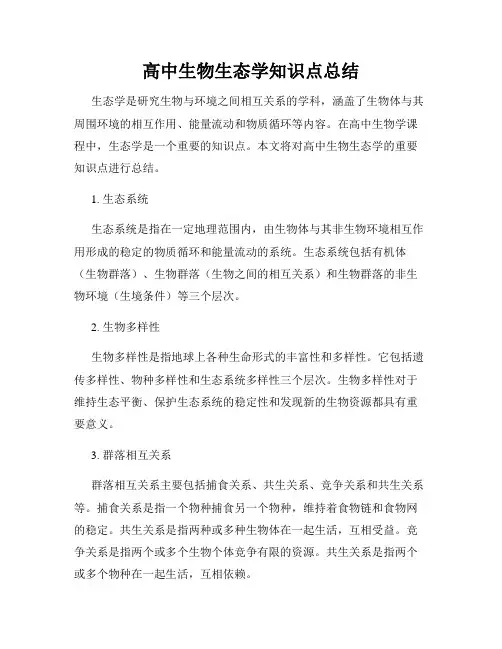
高中生物生态学知识点总结生态学是研究生物与环境之间相互关系的学科,涵盖了生物体与其周围环境的相互作用、能量流动和物质循环等内容。
在高中生物学课程中,生态学是一个重要的知识点。
本文将对高中生物生态学的重要知识点进行总结。
1. 生态系统生态系统是指在一定地理范围内,由生物体与其非生物环境相互作用形成的稳定的物质循环和能量流动的系统。
生态系统包括有机体(生物群落)、生物群落(生物之间的相互关系)和生物群落的非生物环境(生境条件)等三个层次。
2. 生物多样性生物多样性是指地球上各种生命形式的丰富性和多样性。
它包括遗传多样性、物种多样性和生态系统多样性三个层次。
生物多样性对于维持生态平衡、保护生态系统的稳定性和发现新的生物资源都具有重要意义。
3. 群落相互关系群落相互关系主要包括捕食关系、共生关系、竞争关系和共生关系等。
捕食关系是指一个物种捕食另一个物种,维持着食物链和食物网的稳定。
共生关系是指两种或多种生物体在一起生活,互相受益。
竞争关系是指两个或多个生物个体竞争有限的资源。
共生关系是指两个或多个物种在一起生活,互相依赖。
4. 能量流动能量在生态系统中通过食物链和食物网流动。
生物体通过摄取营养物质获得能量,然后在消耗过程中释放能量。
能量从一级生产者到消费者再到更高层级的消费者传递,同时也有一部分能量通过呼吸和排泄散失。
能量的流动与转化决定了生态系统的结构和稳定性。
5. 物质循环生态系统中的物质循环主要包括碳循环、氮循环和水循环。
碳循环是指碳元素在生物圈、大气圈和地球圈之间的循环转化过程。
氮循环是指氮元素从大气中转化为有机氮,再通过食物链在生物体之间传递的过程。
水循环是指水在地球上不同界面之间的循环,包括蒸发、降水、地表径流等过程。
6. 保护生态环境保护生态环境是每个人都应该关注和参与的事情。
我们可以从以下几个方面做出努力:减少二氧化碳排放、节约能源、推广可再生能源、促进生物多样性保护、合理利用土地资源、加强环境教育和宣传等。
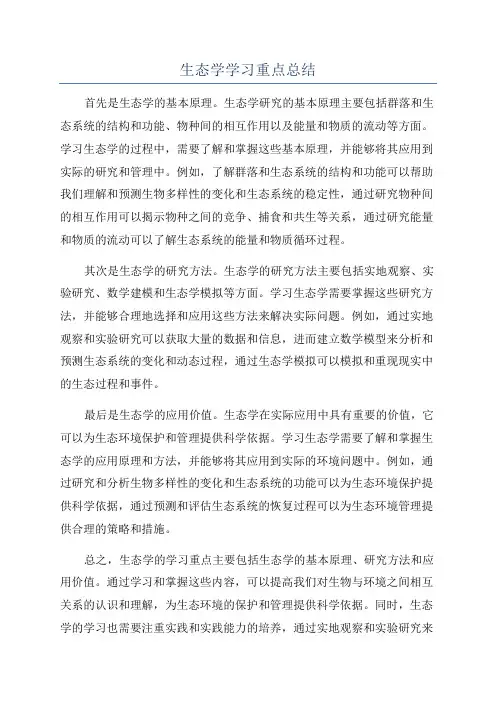
生态学学习重点总结首先是生态学的基本原理。
生态学研究的基本原理主要包括群落和生态系统的结构和功能、物种间的相互作用以及能量和物质的流动等方面。
学习生态学的过程中,需要了解和掌握这些基本原理,并能够将其应用到实际的研究和管理中。
例如,了解群落和生态系统的结构和功能可以帮助我们理解和预测生物多样性的变化和生态系统的稳定性,通过研究物种间的相互作用可以揭示物种之间的竞争、捕食和共生等关系,通过研究能量和物质的流动可以了解生态系统的能量和物质循环过程。
其次是生态学的研究方法。
生态学的研究方法主要包括实地观察、实验研究、数学建模和生态学模拟等方面。
学习生态学需要掌握这些研究方法,并能够合理地选择和应用这些方法来解决实际问题。
例如,通过实地观察和实验研究可以获取大量的数据和信息,进而建立数学模型来分析和预测生态系统的变化和动态过程,通过生态学模拟可以模拟和重现现实中的生态过程和事件。
最后是生态学的应用价值。
生态学在实际应用中具有重要的价值,它可以为生态环境保护和管理提供科学依据。
学习生态学需要了解和掌握生态学的应用原理和方法,并能够将其应用到实际的环境问题中。
例如,通过研究和分析生物多样性的变化和生态系统的功能可以为生态环境保护提供科学依据,通过预测和评估生态系统的恢复过程可以为生态环境管理提供合理的策略和措施。
总之,生态学的学习重点主要包括生态学的基本原理、研究方法和应用价值。
通过学习和掌握这些内容,可以提高我们对生物与环境之间相互关系的认识和理解,为生态环境的保护和管理提供科学依据。
同时,生态学的学习也需要注重实践和实践能力的培养,通过实地观察和实验研究来加深对生态学知识的理解和掌握,从而更好地运用生态学的原理和方法解决实际问题。
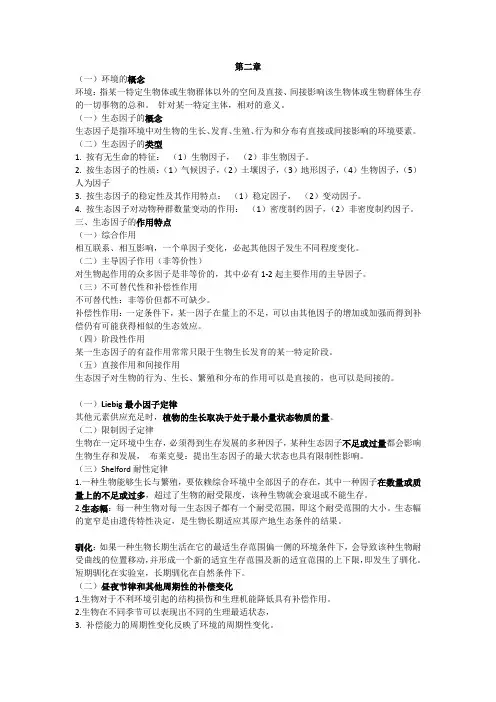
第二章(一)环境的概念环境:指某一特定生物体或生物群体以外的空间及直接、间接影响该生物体或生物群体生存的一切事物的总和。
针对某一特定主体,相对的意义。
(一)生态因子的概念生态因子是指环境中对生物的生长、发育、生殖、行为和分布有直接或间接影响的环境要素。
(二)生态因子的类型1. 按有无生命的特征:(1)生物因子,(2)非生物因子。
2. 按生态因子的性质:(1)气候因子,(2)土壤因子,(3)地形因子,(4)生物因子,(5)人为因子3. 按生态因子的稳定性及其作用特点:(1)稳定因子,(2)变动因子。
4. 按生态因子对动物种群数量变动的作用:(1)密度制约因子,(2)非密度制约因子。
三、生态因子的作用特点(一)综合作用相互联系、相互影响,一个单因子变化,必起其他因子发生不同程度变化。
(二)主导因子作用(非等价性)对生物起作用的众多因子是非等价的,其中必有1-2起主要作用的主导因子。
(三)不可替代性和补偿性作用不可替代性:非等价但都不可缺少。
补偿性作用:一定条件下,某一因子在量上的不足,可以由其他因子的增加或加强而得到补偿仍有可能获得相似的生态效应。
(四)阶段性作用某一生态因子的有益作用常常只限于生物生长发育的某一特定阶段。
(五)直接作用和间接作用生态因子对生物的行为、生长、繁殖和分布的作用可以是直接的,也可以是间接的。
(一)Liebig最小因子定律其他元素供应充足时,植物的生长取决于处于最小量状态物质的量。
(二)限制因子定律生物在一定环境中生存,必须得到生存发展的多种因子,某种生态因子不足或过量都会影响生物生存和发展,布莱克曼:提出生态因子的最大状态也具有限制性影响。
(三)Shelford耐性定律1.一种生物能够生长与繁殖,要依赖综合环境中全部因子的存在,其中一种因子在数量或质量上的不足或过多,超过了生物的耐受限度,该种生物就会衰退或不能生存。
2.生态幅:每一种生物对每一生态因子都有一个耐受范围,即这个耐受范围的大小。
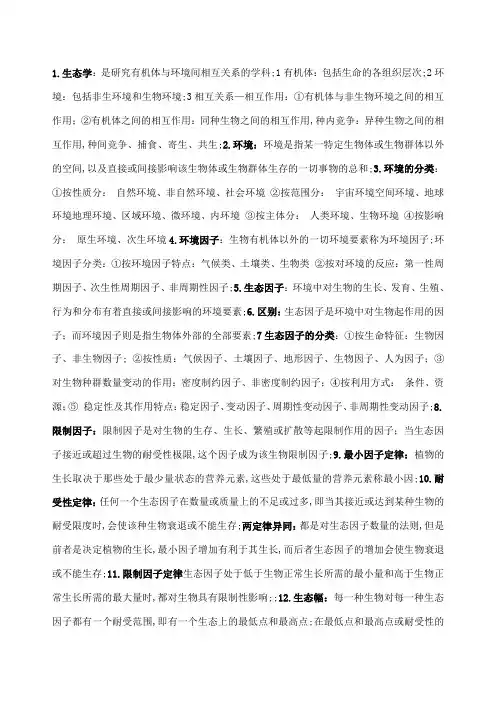
1.生态学:是研究有机体与环境间相互关系的学科;1有机体:包括生命的各组织层次;2环境:包括非生环境和生物环境;3相互关系—相互作用:①有机体与非生物环境之间的相互作用;②有机体之间的相互作用:同种生物之间的相互作用,种内竞争:异种生物之间的相互作用,种间竞争、捕食、寄生、共生;2.环境:环境是指某一特定生物体或生物群体以外的空间,以及直接或间接影响该生物体或生物群体生存的一切事物的总和;3.环境的分类:①按性质分:自然环境、非自然环境、社会环境②按范围分:宇宙环境空间环境、地球环境地理环境、区域环境、微环境、内环境③按主体分:人类环境、生物环境④按影响分:原生环境、次生环境4.环境因子:生物有机体以外的一切环境要素称为环境因子;环境因子分类:①按环境因子特点:气候类、土壤类、生物类②按对环境的反应:第一性周期因子、次生性周期因子、非周期性因子;5.生态因子:环境中对生物的生长、发育、生殖、行为和分布有着直接或间接影响的环境要素;6.区别:生态因子是环境中对生物起作用的因子;而环境因子则是指生物体外部的全部要素;7生态因子的分类:①按生命特征:生物因子、非生物因子; ②按性质:气候因子、土壤因子、地形因子、生物因子、人为因子;③对生物种群数量变动的作用:密度制约因子、非密度制约因子;④按利用方式:条件、资源;⑤稳定性及其作用特点:稳定因子、变动因子、周期性变动因子、非周期性变动因子;8.限制因子:限制因子是对生物的生存、生长、繁殖或扩散等起限制作用的因子;当生态因子接近或超过生物的耐受性极限,这个因子成为该生物限制因子;9.最小因子定律:植物的生长取决于那些处于最少量状态的营养元素,这些处于最低量的营养元素称最小因;10.耐受性定律:任何一个生态因子在数量或质量上的不足或过多,即当其接近或达到某种生物的耐受限度时,会使该种生物衰退或不能生存;两定律异同:都是对生态因子数量的法则,但是前者是决定植物的生长,最小因子增加有利于其生长,而后者生态因子的增加会使生物衰退或不能生存;11.限制因子定律生态因子处于低于生物正常生长所需的最小量和高于生物正常生长所需的最大量时,都对生物具有限制性影响;;12.生态幅:每一种生物对每一种生态因子都有一个耐受范围,即有一个生态上的最低点和最高点;在最低点和最高点或耐受性的上限和下限之间的范围称生态幅或生态价;13.适应方式:形态适应、行为适应、生理适应、营养适应;14.适应:生物适合环境条件而形成一定特性和性状的现象;15.有效积温法则:生物完成某一发育阶段所需的总热量是一个常数,称总积温或有效积温,因此可用公式: K = NT 表示,考虑到生物开始发育的温度,又可写成: K = N T-C 其中,N为完成某阶段的发育所需要的天数,T为发育期间的平均温度,C是发育起点温度,又称生物学零度,K是总积温常数; 有效积温法则的意义①预测生物发生的世代数;②预测生物地理分布的北界;③制定农业气候区划,合理安排作物;④预测害虫来年的发生历程;④应用积温预报农时;16.阿伦规律Allen’s rule:寒冷地区的内温动物较温暖地区内温动物外露部分如四肢、尾、耳朵及鼻有明显趋于缩小的现象,称阿伦规律,是减少散热的适应;贝格曼规律Bergman’s rule:生活在寒冷气候中的内温动物的身体比生活在温暖气候中的同类个体更大,这种趋向称贝格曼规律,是减少散热的适应;约旦规律Jordan’s rule:鱼类的脊椎骨数目在低温水域比在温暖水域的多;17.水对植被的分布的影响:我国从东南到西北可分为3个等雨量区,因而植被类型也分为3个区:湿润森林区、干旱草原区和荒漠区;18.生态因子的不可替代性和补偿性作用:生态因子的缺少,不能由另外因子来替代;但在一定条件下,某一因子数量的不足,可依靠相近生态因子的加强得到补偿;19. 土壤的生态学意义:①为陆生植物提供基底,为土壤生物提供栖息场所;②提供生物生活所必须的矿质元素和水分;③提供植物生长所需的水热肥气;④维持丰富的土壤生物区系;⑤生态系统的许多很重要的生态过程都是在土壤中进行;1种群: 在一定空间中,同种个体的组合;加入相互进行杂交、具有一定结构、一定遗传特性等内容;2种群生物学: 研究种群的结构、形成、发展和运动变化过程规律的科学;最主要组成部分是种群遗传学和种群生态学;3种群的主要特征:①数量特征:种群参数变化是种群动态的重要体现;②空间特征:组成种群的个体在其生活空间中的位置状态或布局,称为种群的内分布型;③遗传特征:种群具有一定的遗传组成,是一个基因库;4种群分布格局:组成种群的个体在其生活空间中的位置状态或布局,称为种群空间格局或内分布型;可有三种类型:①均匀分布:S2/m = 0原因:种群内个体间的竞争;②随机分布:S2/m = 1 原因:资源分布均匀,种群内个体间没有彼此吸引或排斥;③聚集分布:S2/m>1 原因:资源分布不均匀;种子植物以母株为扩散中心;动物的社会行为使其结群;5.年龄结构:不同年龄组的个体在种群内的比例和配置情况;种群各年龄组的个体数或百分比的分布呈金字塔形,因此,称这样的年龄分布称为年龄金字塔或年龄锥体;年龄锥体有三种类型:增长型、稳定型和下降型;种群的年龄分布体现种群存活、繁殖的历史,以及未来潜在的增长趋势,因此,研究种群的历史,便可预测种群的未来;6.内禀增长能力:在种群不受限制的条件下,即能够排除不利的天气条件,提供理想的食物条件,排除捕食者和疾病,我们能够观察到种群的最大增长能力rm ;方程:①公式:dN/dt=rN1-N/K积分式为:Nt=K/1+e的a-rt次方②图形:环境容量K,时间X0-2-20,种群大小Y;开始期-加速期-转折期-减速期-饱和期;③意义:它是两个相互作用种群增长模型的基础;它是渔业、林业、农业等实践领域中确定最大持续产量的主要模型;模型中的两个参数K和r已成为生物进化对策理论中的重要概念;8;生活史生活周期:生物从其出生到死亡所经历的全部过程;关键组分:体形大小、生长率、繁殖、寿命;9.生态对策:各种生物所特有的生活史种群生态特征:如出生率、寿命、大小和存活率等被视为进化过程中获得的生存对策--进化对策;该对策称为生态对策或生活史对策;生活史对策可以理解为生活史的各种成分或整体,在进化过程中形成的适应性响应;繁殖对策、取食对策、避敌对策、扩散对策;10.种内与种间关系:①种内关系:种群内部个体与个体之间的关系;种间关系:同一生境中不同种群之间的关系;②动物和植物的种内关系有所不同:植物的种内关系主要表现为密度效应、集群等;动物的种内关系主要表现为领域性、集群、分散、婚配制度、等级制、利他行为、通讯等;③种间关系主要表现为:竞争、寄生和共生等;11.①合作:指个体通过相互联合,从而对彼此间有利的行为;合作常常是暂时或过渡性的,但也可能是长久性的;合作行为是动物界常见现象;②利他:是指一个体牺牲自我而使社群整体或其他个体获得利益的行为;利他行为可以对直系亲属、近亲家族、整个群体有利;③竞争:是指两物种或更多物种共同利用同样的有限资源时而产生的直接或间接抑制对方的现象;④捕食:一种生物摄取其它种生物个体的全部或部分为食;前者称为捕食者,后者称为猎物或被食者;⑤寄生:是指一个种寄生物寄居于另一个种寄主的体内或体表,从寄主的体液、组织或已消化物质中获取营养,并对宿主造成危害的情况;⑤互利共生:不同种两个个体间的一种互惠关系,可增加双方的适合度;12.生态位:是指物种在生物群落或生态系统中的地位和作用;①基础生态位:生物群落中,某一物种所栖息的理论上的最大空间,称为基础生态位;②实际生态位:生物群落中物种实际占有的生态位空间称实际生态位;多维生态位空间:影响有机体的环境变量作为一系列维,多维变量便是n-维空间,称多维生态位空间,或n-维超体积生态位;13.生态位分化:①生态位重叠: 两物种生态位空间的相互重叠部分,称生态位重叠;②高斯假说:高斯认为两物种越相似,生态位重叠就越多,竞争也就越激烈;共存只能出现在物种生态位分化的稳定、均匀环境中;③生态位漂移:资源竞争而导致两物种的生态位发生变化称生态位漂移;④生态位分离:种间竞争结果使两物种的生态位发生分化,从而使生态位分开;⑤性状替代:竞争产生的生态位收缩导致物种形态性状的变化,叫性状替代;⑥竞争释放:在缺乏竞争者时,物种会扩张其实际生态位,这种现象称竞争释放;1.群落:在特定空间或特定生境下,生物种群有规律的组合,它们之间以及它们与环境之间彼此影响、相互作用,具有特定的形态结构与营养结构,并具有特定功能的生物集合体,这种多种群的集合称群落;2.群落生态学:是研究群落与环境相互关系的科学;3.群落的基本特征:①具有一定的外貌:生长类型②具有一定的种类组成:物种数和个体数;③不同物种之间的相互影响:必须共同适应它们所处的无机环境;它们内部的相互关系必须取得协调和发展种群构成群落的二个条件;④形成群落环境:定居生物对生活环境的改造结果;⑤具有一定的结构:形态结构、生态结构、营养结构;⑥一定的动态特征:季节动态、年际动态、演替与演化;⑦一定的分布范围:特定的地段或特定的生境;⑧群落的边界特征:或明确或不明确的边界;⑨差异性:各物种不具有同等的群落学重要性;4.群落的性质:①机体论学派:群落是一个和生物个体、种群相似的自然单位,是有生命的系统;群落的演替具有定向特征相当于生物的生活史或生物的发育,具有机体特征;代表人物:美国生态学家Clements;②个体论学派:5.种类组成的性质分析:根据各个种在群落中的作用不同,将其划分为几个不同的群落成员型;植物群落研究中,常用的群落成员型有以下几类:①优势种和建群种:对群落的结构和群落环境的形成有明显控制作用的植物称为优势种,优势层的优势种常称为建群种;②亚优势种:指个体数量与作用都次于优势种,但在决定群落性质和控制群落环境方面仍起着一定作用的植物种;③伴生种:伴生种为群落的常见种类,它与优势种相伴存在,但不起主要作用;④偶见种或罕见种:偶见种是那些在群落中出现频率很低的种类;6.种的多样性:①概念:指生物种的多样化和变异性以及物种生境的生态复杂性;它包括植物、动物和微生物的所有种及其组成的群落和生态系统;②两层涵义:种的数目或丰富度;种的均匀度;③三个层次:遗传多样性;物种多样性;生态系统多样性;7.物种多样性的时空变化①空间:纬度:随纬度升高物种多样性降低;海拔:随海拔升高物种多样性降低;水体:随深度增加物种多样性降低;②时间:在群落演替的早期,随着演替的进展,物种多样性增加;在群落演替的后期,物种多样性会降低;8.群落的垂直结构:主要指群落的分层现象;群落的分层与资源光、矿质营养、食物、微气候等利用有关;①植物群落的成层现象光、矿质营养、水分等地上成层现象、地下成层现象、层间植物②动物的分层现象食物、微气候地下、地面、空中;③水生群落的分层主要与光照、温度、食物和溶氧量挺水草本层、飘浮草本层、沉水漂草层、水底层漂浮动物、浮游动物、游泳动物、底栖动物、底内动物;9.群落的水平结构:指群落的配置状况或水平格局,亦称群落二维结构; 植物群落水平结构的主要特征就是它的镶嵌性;是由于植物个体在水平方向上的分布不均匀造成的,从而形成了许多小群落;主要控制因素:气候因素:微气候、径流;土壤因素:营养物质、土壤质地、地形特点;植物因素:他感作用、遮荫作用、繁殖特点;动物因素:喜食情况、种子散布、食物贮藏、践踏、挖洞;10.群落的时间结构:由于不同生物种类的生命活动在时间上的差异,导致群落结构部分在时间上的相互更替,从而构成了群落的时间结构; 周期性、群落季相、昼夜相、年际间变化;11.影响群落组成与结构的因素:生物因素竞争、捕食、干扰、空间异质性群落环境在空间分布上的不均匀的特点称为空间异质性12.中国群落的分类:①中国植物群落分类原则:以群落本身的综合特征种类组成、外貌和结构、地理分布、动态演替和生态环境等作为分类依据,不重叠的等级分类方法;②中国植物分类系统单位:植被型:最主要的高级分类单位;建群种生活型相同或相似,同时对水热条件、生态关系一致的植物群落联合;群系:主要的中级分类单位;建群种或共建种相同的植物群落联合;群丛:基本单位;层片结构相同,各层片优势种或共优势种相同的植物群落联合;每一等级的上下再设一个辅助单位和补充单位组,亚;1.生态系统:指在一定的空间内,生物成分和非生物成分通过物质循环和能量流动互相作用、互相依存而构成的一个生态学功能单位;2.特点:①是生态学的一个主要结构和功能单位,属于现代生态学的研究领域生态系统、景观、全球生态学;经典生态学以动植物种个体、种群和群落为研究对象;②具有能量流动、物质循环和信息传递三大功能;③具有自我调节能力;④是一个动态系统,要经历一系列发育阶段;3.组成①非生物成分有机物、有机化合物、气候因素等②生物成分生产者、消费者、分解者4.生态系统结构是指构成生态系统的要素及其时空分布和物质、能量循环转移的路径;①形态结构空间、时间结构②营养结构食物链、食物网5.功能: ①能量流动:生产者→消费者→分解者,单向;②物质循环:生物←→环境,双向;③信息传递:包括营养信息、化学信息、物理信息和行为信息等,构成信息网;6.食物链:①定义:生态系统中,由食物关系把多种生物联系起来,彼此形成一个以食物联系起来的连锁关系,称之为食物链;②食物链的类型:据食物链的起点不同,分成两种类型:牧食食物链:又称捕食食物链,以活的动植物为起点的食物链,如绿色植物-草食动物-各级食肉动物;寄生食物链可以看作捕食食物链的一种特殊类型;腐食食物链:又称碎屑食物链,从分解死亡的有机体或腐屑开始;7.食物网:生态系统中的食物链很少是单条、孤立出现的,它往往是交叉链索,形成复杂的网络结构,此即食物网;食物网本质上反映了生态系统中各有机体之间相互捕食关系和广泛的适应性;8.食物链和食物网的意义: ①生态系统中能量流动物和物质循环是沿着食物链和食物网进行的;②食物链是生态系统营养结构的形象体现;通过食物链和食物网把生物与非生物、生产者与消费者、消费者与消费者连成一个整体,反映了生态系统中各生物有机体之间的营养位置和相互关系;③各生物成分间通过食物网发生直接和间接的联系,保持着生态系统结构和功能的稳定性,维持着生态系统的相对平衡,并推动着生物的进化,成为自然界发展演变的动力;④食物链和食物网还揭示了环境中有毒污染物转移、积累的原理和规律;9.营养级:食物链中每一个环节上一切生物的总和,都是一个营养级;生态系统中的物质和能量就是通过营养级向上传递;10.生态金字塔:能量金字塔;生物量金字塔;生物数目金字塔;11.生态系统的演替:生态系统是一个动态系统,其结构和功能随着时间的推移而不断地改变,生态学把这种改变称之为生态演替;生态系统的演替缘于生态系统的内部的自我调节以及外部环境的影响;自我调节能力的大小取决于系统组成和结构;12.生态系统的反馈调节:反馈:当生态系统中某一成分发生变化的时候,它必然引起其它成分出现一系列的相应变化,这些变化最终反过来影响最初发生变化的那种成分,这个过程就叫反馈;有两种类型:①正反馈:生态系统中某一成分的变化所引起的其它一系列的变化,不是抑制而是加速最初发生变化的成分所发生的变化;其作用使生态系统远离平衡状态或稳定;比较少见,破坏作用大,爆发性的;②负反馈:生态系统中某一成分的变化所引起的其它一系列的变化,抑制和减弱最初发生变化的那种成分所发生的变化;其作用使生态系统达到和保持平衡状态或稳定;常见;长远看,生态系统的负反馈和自我调节起主要作用;13.生态平衡指生态系统通过发育和调节达到一种稳定状态,表现为结构、功能、能量输入和输出的稳定;②对生态平衡的认识:生态系统的平衡是一种动态平衡;当受到外来因素干扰没有超过一定限度时,生态系统仍能通过自我调节恢复原来状态;当干扰超过一定限度时,平衡将受到破坏,产生生态危机;③生态平衡破坏生态系统自我调节能力和对外界干扰的忍耐能力是有一定限度的,当干预因素的影响超过其生态系统的阈值自我调节能力的极限值时,自我调节能力将随之降低或消失,从而引起生态失调,甚至造成生态系统的崩溃;④原因:自然因素:火山爆发、地震、海啸、台风、水旱灾害等;人为因素:人类不合理的行为修建大型工程、排放污染物、喷散农药、引入物种等、政策失误等;14初级生产:植物固定太阳能制造有机物质的过程称为初级生产或第一性生产;陆地生态系统中,初级生产量是由光、CO2 、H2O、营养物质基本资源、氧和温度影响光合效率以及食草动物的捕食减少光合作用生物量六个因素决定的;15.生物量:是指某一时刻单位面积上积存的有机物质的量;以鲜重或干重表示;单位:g/m2或J/m2;16次级生产:动物消耗植物的初级生产量,制造自己的有机物质和固定能量的过程,称为次级生产或第二性生产;17.分解作用:分解者将残株、尸体等复杂的有机质逐步降解的过程;①分解的三个过程:碎裂:颗粒体的粉碎,是一迅速的物理过程;主要的改变是动物生命活动的过程,当然也包括生物的和非生物的作用如风化、结冰、解冻和干湿作用等;异化:有机物质在酶的作用下,进行生物化学分解,分解为单分子的物质如纤维素降解为葡萄糖或无机物葡萄糖降为CO2和H2O;淋溶:纯物理过程,是指水将资源中的可溶解成分解脱出来,其速率实际上也受上两个过程的影响;②理论意义:维持全球生产和分解的平衡;植物的初级生产和资源的分解是生态系统能量和物质流中的两个主要过程;资源分解的主要作用是:--通过死亡物质的分解,使营养物质再循环,给生产者提供营养物质;-维持大气中二氧化碳的浓度;--稳定和提高土壤有机质含量,为碎屑食物链以后各生物生产食物;--改善土壤物理性状,改造地球表面惰性物质;实践意义:--粪便处理--污水处理18.能量流动过程①能量流动的起点:生产者固定的太阳能②流经生态系统的总能量:生产者固定的太阳能总量③能量流动的途径渠道:食物链和食物网④能量流动的过程⑤能量的散失:呼吸作用19.能量流动的特点①能流在生态系统中是变化着的;②能流是单向流动的;能量以光能的状态进入生态系统后,就不能再以光的形式存在,而是以热的形式不断地逸散于环境中;③能量在流动过程中,不断递减;20.生态效率:是指各种能流参数中的任何一个参数在营养级之间或营养级内部的比值关系;最重要的生态效率有同化效率、生长效率、消费或利用效率、林德曼效率;21.生物浓缩:生态系统中同一营养级上的许多生物种群或者生物个体,从周围环境中蓄积某种元素或难分解的化合物,使生物体内该物质的浓度超过环境中的浓度的现象,又称为生物富集.22.生物积累:生态系统中生物不断进行新陈代谢的过程中,体内来自环境的元素或难分解化合物的浓缩系数不断增加的现象;23.生物放大:在生态系统的食物链上,高营养级生物以低营养级生物为食,某种元素或难分解化合物在生物体中浓度随着营养级的提高而逐渐增大的现象;24.水循环①水循环的意义:生物体的70%是由水构成的,生命离不开水;水是很好的溶剂,是所有营养物质的介质,影响着各类营养物质在地球上的分布;水是地质变化的动因之一;②水循环的方式:蒸发、降水;每年地球表面蒸发量等于降水量. ③水循环的途径25.人类活动对水循环的影响: ①污染;②修筑水库、塘堰可扩大自然蓄水量;③围湖造田又使自然蓄水容积减小;④过度开采利用地下水,使某些人口集中的地区出现了地下水位和水质量的下降,如目前我国许多北方大城市的地下水分布出现“漏斗”;26. ①碳的循环主要是通过CO2进行的图3-4;环境中的CO2通过光合作用被固定在有机物质中,然后通过食物链的传递,在生态系统中进行循环;②碳循环中环境问题:第二次工业革命以来,大量化石燃料的燃烧,改变了原有的碳素平衡状态;由于森林被砍伐,减少了对CO2的固定,因此,尽管海洋能够吸收近2/3的额外碳源,仍然避免不了全球大气CO2浓度的升高; CO2的“温室效应”加剧将导致全球温度升高和降水分布的改变;27. ①硫在自然界中存在多种形态,元素硫、二氧化硫、硫酸盐和气态的硫化物等;②硫的循环过程:岩浆活动、燃料燃烧、海面散发及有机物分解--大气--土壤--植物--动物--土壤--海洋沉积岩或植物③硫循环中的环境问题:工业革命以来,大量燃烧煤、石油等化学燃料,大大增加了大气中二氧化硫的含量,引起全球性的环境问题之一----酸雨的产生;。
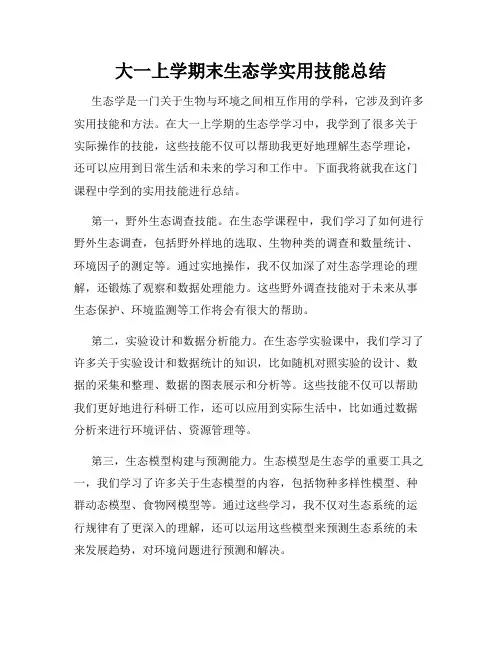
大一上学期末生态学实用技能总结生态学是一门关于生物与环境之间相互作用的学科,它涉及到许多实用技能和方法。
在大一上学期的生态学学习中,我学到了很多关于实际操作的技能,这些技能不仅可以帮助我更好地理解生态学理论,还可以应用到日常生活和未来的学习和工作中。
下面我将就我在这门课程中学到的实用技能进行总结。
第一,野外生态调查技能。
在生态学课程中,我们学习了如何进行野外生态调查,包括野外样地的选取、生物种类的调查和数量统计、环境因子的测定等。
通过实地操作,我不仅加深了对生态学理论的理解,还锻炼了观察和数据处理能力。
这些野外调查技能对于未来从事生态保护、环境监测等工作将会有很大的帮助。
第二,实验设计和数据分析能力。
在生态学实验课中,我们学习了许多关于实验设计和数据统计的知识,比如随机对照实验的设计、数据的采集和整理、数据的图表展示和分析等。
这些技能不仅可以帮助我们更好地进行科研工作,还可以应用到实际生活中,比如通过数据分析来进行环境评估、资源管理等。
第三,生态模型构建与预测能力。
生态模型是生态学的重要工具之一,我们学习了许多关于生态模型的内容,包括物种多样性模型、种群动态模型、食物网模型等。
通过这些学习,我不仅对生态系统的运行规律有了更深入的理解,还可以运用这些模型来预测生态系统的未来发展趋势,对环境问题进行预测和解决。
第四,实用软件和工具的运用。
在生态学课程中,我们学习了许多生态学领域的实用软件和工具,比如地理信息系统(GIS)、遥感技术、光谱仪等。
这些工具可以帮助我们更好地获取和处理数据,对于从事生态学研究和相关工作将会大有帮助。
通过大一上学期的生态学学习,我不仅学到了许多生态学理论知识,还掌握了许多实用技能,这些技能将会对我的未来学习和工作产生积极的影响。
我相信,在未来的学习和生活中,这些实用技能一定会发挥重要作用,让我在生态学领域有更好的发展和应用。
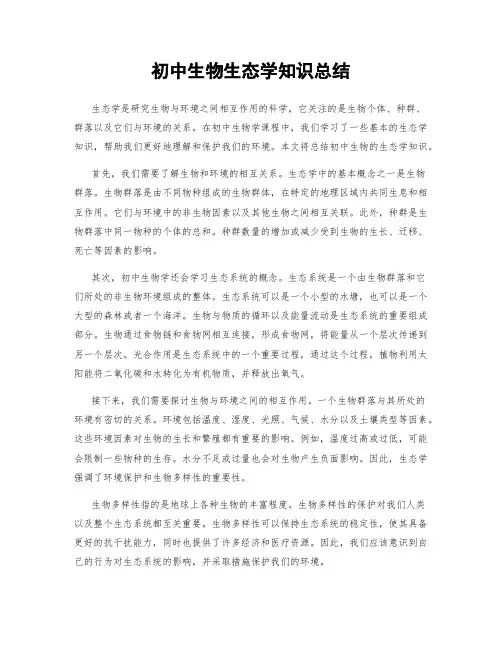
初中生物生态学知识总结生态学是研究生物与环境之间相互作用的科学,它关注的是生物个体、种群、群落以及它们与环境的关系。
在初中生物学课程中,我们学习了一些基本的生态学知识,帮助我们更好地理解和保护我们的环境。
本文将总结初中生物的生态学知识。
首先,我们需要了解生物和环境的相互关系。
生态学中的基本概念之一是生物群落。
生物群落是由不同物种组成的生物群体,在特定的地理区域内共同生息和相互作用。
它们与环境中的非生物因素以及其他生物之间相互关联。
此外,种群是生物群落中同一物种的个体的总和。
种群数量的增加或减少受到生物的生长、迁移、死亡等因素的影响。
其次,初中生物学还会学习生态系统的概念。
生态系统是一个由生物群落和它们所处的非生物环境组成的整体。
生态系统可以是一个小型的水塘,也可以是一个大型的森林或者一个海洋。
生物与物质的循环以及能量流动是生态系统的重要组成部分。
生物通过食物链和食物网相互连接,形成食物网,将能量从一个层次传递到另一个层次。
光合作用是生态系统中的一个重要过程,通过这个过程,植物利用太阳能将二氧化碳和水转化为有机物质,并释放出氧气。
接下来,我们需要探讨生物与环境之间的相互作用。
一个生物群落与其所处的环境有密切的关系。
环境包括温度、湿度、光照、气候、水分以及土壤类型等因素。
这些环境因素对生物的生长和繁殖都有重要的影响。
例如,温度过高或过低,可能会限制一些物种的生存。
水分不足或过量也会对生物产生负面影响。
因此,生态学强调了环境保护和生物多样性的重要性。
生物多样性指的是地球上各种生物的丰富程度。
生物多样性的保护对我们人类以及整个生态系统都至关重要。
生物多样性可以保持生态系统的稳定性,使其具备更好的抗干扰能力,同时也提供了许多经济和医疗资源。
因此,我们应该意识到自己的行为对生态系统的影响,并采取措施保护我们的环境。
最后,生态学中还有一个重要的概念是生态足迹。
生态足迹是指一个人、一个国家或者人类整体对生态系统的影响和需求的度量。
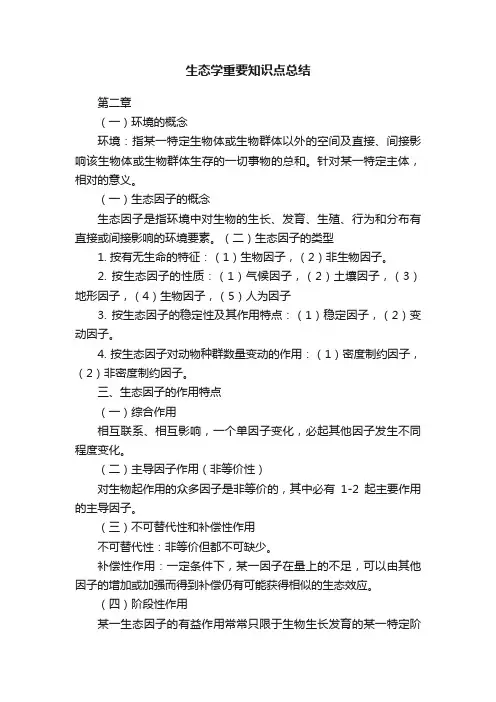
生态学重要知识点总结第二章(一)环境的概念环境:指某一特定生物体或生物群体以外的空间及直接、间接影响该生物体或生物群体生存的一切事物的总和。
针对某一特定主体,相对的意义。
(一)生态因子的概念生态因子是指环境中对生物的生长、发育、生殖、行为和分布有直接或间接影响的环境要素。
(二)生态因子的类型1. 按有无生命的特征:(1)生物因子,(2)非生物因子。
2. 按生态因子的性质:(1)气候因子,(2)土壤因子,(3)地形因子,(4)生物因子,(5)人为因子3. 按生态因子的稳定性及其作用特点:(1)稳定因子,(2)变动因子。
4. 按生态因子对动物种群数量变动的作用:(1)密度制约因子,(2)非密度制约因子。
三、生态因子的作用特点(一)综合作用相互联系、相互影响,一个单因子变化,必起其他因子发生不同程度变化。
(二)主导因子作用(非等价性)对生物起作用的众多因子是非等价的,其中必有1-2起主要作用的主导因子。
(三)不可替代性和补偿性作用不可替代性:非等价但都不可缺少。
补偿性作用:一定条件下,某一因子在量上的不足,可以由其他因子的增加或加强而得到补偿仍有可能获得相似的生态效应。
(四)阶段性作用某一生态因子的有益作用常常只限于生物生长发育的某一特定阶段。
(五)直接作用和间接作用生态因子对生物的行为、生长、繁殖和分布的作用可以是直接的,也可以是间接的。
(一)Liebig最小因子定律其他元素供应充足时,植物的生长取决于处于最小量状态物质的量。
(二)限制因子定律生物在一定环境中生存,必须得到生存发展的多种因子,某种生态因子不足或过量都会影响生物生存和发展,布莱克曼:提出生态因子的最大状态也具有限制性影响。
(三)Shelford耐性定律1.一种生物能够生长与繁殖,要依赖综合环境中全部因子的存在,其中一种因子在数量或质量上的不足或过多,超过了生物的耐受限度,该种生物就会衰退或不能生存。
2.生态幅:每一种生物对每一生态因子都有一个耐受范围,即这个耐受范围的大小。
生态学重要知识点归纳总结生态学重要学问点归纳总结Revised by Hanlin on 10 January 2022环境:指某一特定生物体或生物群体周围一切的综合,包括空间及直接或间接影响该生物群体生存的各种因素。
生物环境:A大环境:地区环境(地球环境,宇宙环境)/a大气候:离地面以上的气候,由大范围因素打算。
B小环境:对生物有直接影响的领接环境/b小气候:生物所处的局域地区的气候大环境直接影响小环境影响生物,生物反作用环境。
生态因子:指环境要素中对生物起作用的因子(CO2 、H2O 、食、天敌……)分类:A性质:1气候因子2土壤因子3地形因子4生物因子5人为因子B有无生命特征:1生物因子2非生物因子C 生态因子对动物种群数量的变动作用:1密度制约因子(食物,天地)2非密度制约因子(气候,降水)D生态因子的稳定性及作用特点:1稳定因子(引力,光强)2变动因子{周期性变动因子(四季,潮汐)非周期性变动因子}生态因子的作用特征:1综合作用2主导因子作用3阶段性作用4不行代替性和补偿性作用5直接或间接作用生境:特定生物体或群体的栖息地的生态环境(全部生态因子构成生态环境)利比希最小因子定律:地域某种生物余姚的最小量的任何特定因子,是打算该生物生存和分布的根本因素限制因子:任何生态因子,当临近或超过某生物的耐受性极限而妨碍其生存,生长,繁殖或蔓延时之歌因素称为限制因子耐受性定律:任何一个生态因子在数量上或质量上的不足或过多,即当临近或达到某种生物的耐受限度时会使该生物衰退或不能生存生态幅:每一种生物对每一种生态因子都有一个耐受范围,即一个生态上的最高点和最低点,在最高点和最低的之间的范围称为生态幅光质的生态作用:尽管生物生活在日光全光谱下,但不同的光质对生物的作用是不同的,生物对光质也产生了挑选性适应光合有效辐射:光合作用系统只能够利用太阳光谱的一个有限带,即380-710nm 波长的辐能,这个带对应于辐射能流的最大节黄化现象:普通植物在黑暗中不能合成叶绿素,但能形成胡萝卜素,导致叶子发黄植物物种间对光照强度表现出的适应性差异,是已进化的两类值物间的差异:1阳地植物2阴地植物动物对光照强度的适应:1昼行动物2夜行动物自然条件下,动物天天开头活动的时光经常是由光照强度打算的,当光照强度达到某一水平常,动物才开头活动,因此不同时节随着日出日落的时光差异,动物活动时光也有变化生物光周期现象:植物的开花结果,落叶及休眠,动物的繁殖,冬眠,迁徙和换毛换羽毛等,是对日照长短的逻辑性变化的反应。
生态学学习总结了解生态系统与物种保护掌握环境保护与可持续发展理念生态学学习总结:了解生态系统与物种保护,掌握环境保护与可持续发展理念近年来,随着人类活动的不断扩大和发展,生态环境面临着严重的破坏和威胁。
为了保护生态系统和物种多样性,推动环境保护和可持续发展,我进行了一系列的生态学学习。
通过学习,我对生态系统与物种保护的重要性有了更深入的认识,并掌握了环境保护与可持续发展的理念。
一、生态系统与物种保护的重要性生态系统是地球上生物和其非生物环境相互作用形成的复杂系统,是维系生物多样性和人类生存的基础。
物种保护是保护和维护生物多样性的重要手段,对维持生态平衡、维护生态系统的完整性至关重要。
在生态学的学习中,我了解到生态系统的构成要素包括生物群落、种群、个体以及它们与环境的相互作用。
在生物多样性方面,我认识到不同物种之间相互依赖、相互关联,构成了复杂的食物链、食物网。
而这些生态系统和物种正遭受着破坏和威胁,如森林砍伐、生境破坏、气候变化等。
因此,保护和恢复生态系统,保护濒危物种,成为了当前亟待解决的问题。
二、环境保护与可持续发展的理念环境保护是指通过各种措施来保护和改善环境,减少对自然资源的消耗和破坏,维护生态平衡,确保人类和其他生物的可持续发展。
可持续发展是指在满足当前需求的基础上,不破坏或最小程度破坏自然环境的前提下,满足子孙后代的需求。
环境保护与可持续发展的理念贯穿了整个生态学学习的过程。
学习中,我深入了解了环境问题的严重性以及其对人类生活和经济发展的影响。
同时,我也积极了解并采取行动,如推动节能减排、倡导资源循环利用、参加环保志愿活动等,为环境保护和可持续发展贡献自己的力量。
三、生态学学习的收获与感悟通过这段时间的学习,我不仅从理论上了解了生态系统与物种保护的重要性,也通过实地考察和参与实践活动,亲身感受到了环境保护与可持续发展的重要意义。
首先,我明白了生态系统是一个复杂而脆弱的系统,它承载着众多生物的生存与繁衍。
生态学应用理论知识点总结生态系统是指在一定空间范围内,包括生物和非生物因素相互作用维持其稳定的自然系统。
生态系统的组成要素包括生物要素和非生物要素。
生态系统的结构包括两个方面:生物成分、非生物成分。
生态学应用理论中的生态系统知识点包括但不限于:1. 生物成分(1) 生物多样性:生态系统中包括的不同种类的生物,包括物种多样性、基因多样性和生态系统多样性。
(2) 养分循环:生态系统中的养分包括碳、氮、磷、硫等,它们通过生物过程和生物非生物相互作用不断循环。
2. 非生物成分(1) 水、土壤、空气:生态系统中的非生物成分对生态系统的稳定和健康至关重要。
(2) 物理因子:如温度、湿度、光照等,对生态系统的生物成分和非生物成分起着重要的调节作用。
生态系统知识点不仅包含了生态系统的结构,还包括了生态系统的功能,如能量流动、物质循环等。
同时,生态系统的稳定性和动力学也是生态学应用理论中所关注的重要知识点。
生态系统的稳定性是指系统在受到外界干扰后仍能维持其结构和功能的能力。
生态系统的动力学是指系统在长期演变过程中所呈现出来的结构、功能和动态变化。
物种是生态系统的重要组成部分,物种的多样性、分布、演化和维持都是生态学应用理论中所关注的知识点。
物种多样性是指生态系统中不同物种的丰富度和种类的多样性,是生态系统稳定性的重要指标。
物种分布和演化是指物种在地理空间和时间尺度上的分布和演化规律。
物种维持是指物种在生态系统中维持自身数量和多样性的机制和过程。
群落是指在一定空间范围内,由各种不同物种组成的生态系统。
群落的结构、功能和相互作用是生态学应用理论中的重要知识点。
群落的结构包括物种组成、竞争关系、捕食关系和共生关系等。
群落的功能包括光合作用、有机物质分解和无机物质循环等。
群落的相互作用是指物种与物种之间、物种与环境之间的相互作用。
生态学方法是生态学研究的方法和技术。
生态学方法包括实地调查、实验研究、数学模型以及现代技术手段等。
普通生态学学习心得生态学作为一门研究生物和环境之间相互关系的学科,对于我们认识和保护自然环境具有重要的意义。
在我所学的普通生态学课程中,我深入学习了生态系统的结构和功能、生物种群的动态和调控以及物种多样性的维持与恢复等内容。
在学习的过程中,我深刻认识到了生态学的重要性,并从中获得了许多启发和感悟。
首先,生态学教给了我一种整体观的思维方式。
生态学关注的是生物和环境之间的相互作用,强调物种之间、物种与环境之间的相互联系和相互依存。
在生态学的视角下,任何一个生物都不是独立存在的,它们都是生态系统中的一部分,与其他物种相互作用。
这种整体观的思维方式帮助我更好地理解生态系统的复杂性和动态性,也让我意识到了人类活动对于生态系统的影响和破坏。
通过生态学的学习,我学会了从整体的角度去思考问题,意识到了生态环境的连续性和相互依赖性。
其次,生态学教会了我如何观察和理解自然界中的现象。
生态学通过实地调查和实验研究,帮助我了解了生物多样性的分布规律、生态系统的结构和功能以及生物群落的动态变化等。
在课程中,我们进行了一系列的实验和调查,例如田间实验观察植物竞争的结果、调查不同生境下的鸟类多样性等。
通过这些实践活动,我学会了如何进行科学观察和数据收集,并从中进一步认识到了自然界中的规律和关系。
这对于我未来的研究工作和环境保护实践具有重要的指导意义。
此外,生态学教给了我如何维护和恢复生态系统的方法和策略。
生态系统是由不同的生物种群和非生物因素组成的复杂系统,它们之间存在着多种相互作用和相互制约。
在面对生态系统退化和破坏的问题时,我们需要采取有效的措施来保护和恢复生物多样性和生态系统的稳定性。
通过学习生态学,我了解了许多生态恢复的方法和策略,例如通过植树造林来改善土壤质量,通过限制捕捞量来保护渔业资源等。
这些措施既有理论依据,又有实践经验支持,对于生态环境的保护和可持续发展具有重要的意义。
最后,生态学让我意识到了自然界中的美与真理。
基础生态学知识点总结生态学是研究生物与环境之间相互作用关系的科学,它关注着生物与环境之间的能量流动、物质循环、种群动态和群落结构等方面的问题。
本文将从生态学的基础知识点出发,对生态学的几个重要概念进行总结和阐述。
一、生态系统生态系统是指生物体与其非生物环境之间相互作用的功能单位。
生态系统由生物群落和其所处的非生物环境组成。
生态系统的组成部分包括生物圈、生物群落、生态位、生物多样性等。
1. 生物圈:指地球上所有生物体的居住空间,包括陆地、水域和大气层等。
2. 生物群落:是指在同一生境中生活在一起的各种物种。
生物群落是研究生态系统结构和功能的基本单位。
3. 生态位:是指一个物种在生态系统中的特定位置和角色。
每个物种都有其独特的生态位,不同的物种通过利用不同的资源和生境来避免直接竞争。
4. 生物多样性:指生物体在空间和时间上的多样性。
生物多样性包括物种多样性、遗传多样性和生态系统多样性。
二、能量流动与物质循环生态学研究生物与环境之间的能量流动和物质循环。
能量流动是指太阳能被生物体吸收并转化为化学能的过程。
物质循环是指生物体通过食物链和食物网相互作用,使有机物和无机物在生态系统中循环和再利用。
1. 光合作用:是指植物和某些细菌利用太阳能将二氧化碳和水转化为有机物和氧气的过程。
光合作用是能量流动和物质循环的起点。
2. 食物链:是指各种生物通过进食和被进食的关系,将能量和物质从一个物种传递到另一个物种的过程。
食物链由生物体依次排列,形成一个层次结构。
3. 食物网:是指多个食物链相互交织在一起,形成复杂的网络结构。
食物网中的每个物种都可以同时充当捕食者和被捕食者的角色,使能量和物质在生态系统中循环。
三、种群动态和群落结构种群动态和群落结构是生态学研究的重要内容,它们反映了生物群落的稳定性和演替过程。
1. 种群:是指同一物种在同一地区和同一时间内的所有个体的总和。
种群的数量和密度、出生率和死亡率、迁移和扩散等因素都会影响种群的动态。
生态学背诵笔记总结
生态学是研究生物与环境之间相互作用的科学,是一门综合性学科。
下面是生态学的背诵笔记总结:
1. 生态系统
- 生态系统是由生物群体与其所处环境的相互作用所构成的。
它包括生物群体、生物种群、生物个体、生物化学循环和能量流动。
2. 环境因素
- 环境因素包括生物因素和非生物因素。
生物因素有物种的竞争、合作和捕食关系。
非生物因素有气候、土壤、水分和光照等。
3. 生态位
- 生态位是指一个物种在其所处环境中的特定位置和角色。
它
包括物种的生活方式、生境利用和资源利用等。
4. 群落生态学
- 群落生态学研究不同物种在同一地点共同生活的群落,并研
究它们之间的相互作用和竞争关系。
5. 能量流动
- 能量流动是指能量在生态系统中的传递和转化过程。
它起源
于太阳能的输入,通过食物链或食物网的形式在生物之间流动。
6. 生物多样性
- 生物多样性是指生物体在遗传、物种和生态系统三个层次上
的多样性。
它对维持生态系统功能和生态平衡至关重要。
7. 生态承载力
- 生态承载力是指一个生态系统能够容纳和支持的生物种群数
量和物种多样性的最大值。
它受到环境因素和生物种群交互作用的限制。
8. 生态危机
- 生态危机是指由于人类活动导致的生态系统破坏和环境污染,进而影响物种的存活和生活质量。
解决生态危机是保护生态环境的重要任务。
以上是生态学的背诵笔记总结,希望对您有所帮助。
1.Environment limits the geographic distribution of species.环境限制了物种在地理上的分布。
2.On small scales, individuals within populations are distributed in patterns that may berandom, regular, or clumped.在小尺度上,群体内个体的分布模式,可能是随机的,固定的,或聚集的。
3.Population density declines with increasing organism size.种群密度随有机体大小的增加的下降。
4.Abundance丰度:研究体系中被研究元素的相对含量。
5.Niche生态位:物种在环境中所处的地位以及食物、行为等细节。
6.Fundamental niche基础生态位:一个物种在无别的竞争物种存在时所占有的生态位。
7.Population种群:在一定时间内占据一定空间的同种生物的所有个体。
8.Realized niche实际生态位:有别的物种竞争存在时的生态位。
P2421.Dispersal can increase or decrease local population densities.扩散可以增加或减少当地的种群密度。
2.Ongoing dispersal can join numerous subpopulations to form a metapopulation.许多亚群可以加入正在扩散的种群形成一个集合种群。
3. A survivorship curve summarizes the pattern of survival in a population.存活曲线总结了种群的生存模式。
4.The age distribution of a population reflects its history of survival, reproduction, andpotential for future growth.种群的年龄分布反映了其在历史上的生存,繁殖,和未来的增长潜力。
5. A life table combined with a fecundity schedule can be used to estimate net reproductiverate, geometric rate of increase, generation time, and per capital rate of increase.一个了结合生殖力表格的生命表可以用来估计净生殖率,几何增加率,世代时间,平均种群的增加率。
6.Cohort同生群:在种群统计学中常把同一时间段中出生的动物称为同生群。
7.Geometric rate of increase几何增长率:种群的增长按照几何级数增加时所对应的种群增长率。
8.Life table生命表:分析种群死亡过程的表格。
9.Population dynamics种群动态:种群动态研究种群数量在时间上和空间上的变动规律.10.Survivorship curve存活曲线:以存活数量的对数值为纵坐标,以年龄为横坐标作图,从而把每一个种群的死亡—存活情况绘成一条曲线。
1.In the presence of abundant resources, populations can grow at geometric or exponentialrates.在资源丰富的地方,种群可以以几何或指数增长率。
2.As resources are depleted, population growth rate slows and eventually stops; this is knownas logistic population growth.随着资源的枯竭,种群增长速度减慢,最终停止;这就是Logistic人口增长。
3.The environment limits population growth by changing birth and death rates.环境通过改变出生率和死亡率的来限制种群增长。
4.Carrying capacity容纳量:即某一自然环境可容纳某种生物的最大数量5.Exponential population(不确定)种群指数增长:假定在无限的环境中,种群增长是无限的,不受资源,空间等条件的限制;种群就发挥其内禀增长能力,种群增长呈指数式增长格局,这种增长规律,称种群的指数式增长。
可分为两类:世代不相重叠种群的离散增长和世代重叠种群的连续增长。
6.Intrinsic rate of increase内禀增长率:在特定条件下,具有稳定年龄组配的生物种群不受其他因子限制时的最大瞬时增长速率。
7.Logistic population随着资源的枯竭,种群增长速度减慢,最终停止。
P307boratory and field studies reveal intraspecific competition.实验室和现场研究揭示种内竞争。
2.The competitive exclusion principle proposes that two species with identical niches cannotcoexist indefinitely, which leads to the prediction that coexisting species will have different niches.竞争排斥原理提出,相同的两物壁龛物种不能共存下去,这预测表明共存的物种将有不同的生态位。
3.Mathematical and laboratory models provide a theoretical foundation for studyinginterspecific competition in nature.数学和实验室模型提供了研究野生种间竞争的理论基础。
petition can have significant ecological and evolutionary influences on the niches ofspecies.竞争可以对物种的生态位有显著的在生态和进化上的影响。
5.Interspecific competition种间竞争:两种或更多种生物共同利用同一资源而产生的相互妨碍作用。
6.Intraspecific competition种内竞争:同种个体间利用同一资源而发生的相互妨碍作用。
P3751.Most species are moderately abundant; few are very abundant or extremely rare.大多数物种适度地丰富;少数一些非常丰富或非常罕见。
2. A combination of the number of species and their relative abundance defines speciesdiversity.物种的数量和它们的相对丰度的结合综合定义物种多样性。
3.Species diversity is higher in complex environments.在复杂的环境中的物种多样性高。
4.Intermediate levels of disturbance promote higher diversity.中度的干扰促进多样性的提高。
munity群落:亦称生物群落(biological community)。
是具有直接或间接关系的多种生物种群的有规律的组合,具有复杂的种间关系,或称生物的总合。
munity structure群落结构:群落是一个有机的、有规律的系统,它具一定结构。
分为垂直结构,水平结构,时间结构和层片结构。
7.Intermediate disturbance hypothesis中度干扰假说:由美国生态学家康奈尔(J. H. Connell)等人于1978年提出的一个假说,认为中等程度的干扰频率能维持较高的物种多样性。
如果干扰频率过低,少数竞争力强的物种将在群落中取得完全优势;如果干扰频率过高,只有那些生长速度快、侵占能力特强的物种才能生存下来;只有当干扰频率中等时,物种生存的机会才是最多的,群落多样性最高。
8.Species diversity物种多样性:是生物多样性的简单度量,是指动物,植物和微生物种类的丰富性,它们是人类生存和发展的基础。
9.Species evenness物种均匀度:一个群落中全部物种个体数目的分配状况。
10.Species richness物种丰富度:群落中物种数目的多少。
P3971. A food web summarizes the feeding relations in a community.食物网概述为一个群落里的觅食关系。
2.Indirect interactions between species are fundamental to communities.物种之间的间接相互作用是群落的基本。
3.The feeling activities of a few keystones species may control the structure of communities.少数重点物种的感觉活动可以控制群落结构。
(不确定)4.Mutualists can act as keystone species.共生体可以作为关键物种。
5.Dominate, or foundation, species(不确定)占主导地位,或基础,物种。
6.Food web食物网:又称食物链网或食物循环。
是生态系统中生物间错综复杂的网状食物关系。
7.Keystone species关键物种:在一个群落中与其他种相互影响、并决定其他许多种生存的物种。
P4171.Terrestrial primary production is generally limited by temperature moisture.陆地初级生产一般被温度湿度限制。
2.Aquatic primary production is generally limited by nutrient availability.水域初级生产力一般被养分的供应限制。
3.Consumers can influence rates of primary production in aquatic and terrestrial ecosystemsthrough trophic cascades.取食者可以通过营养级联影响水生和陆地生态系统的初级生产速率。